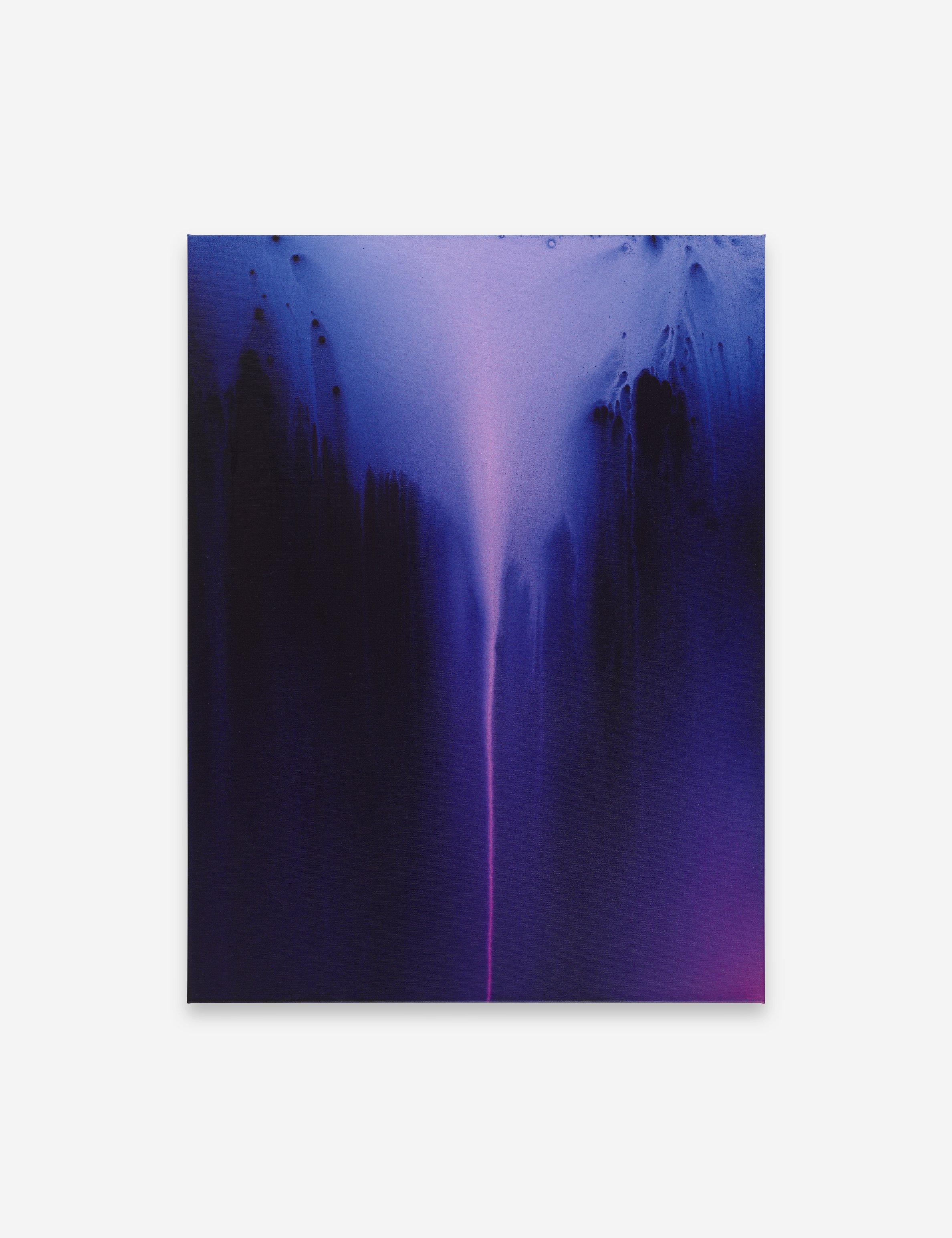GRAVITY SYSTEM RESPONSE
ASH KEATING
May 12 - June 18, 2022


GRAVITY SYSTEM RESPONSE
Ash Keating
May 12 - June 18, 2022
Opening: Thursday, May 12 from 6-8pm
5 Harrison St
New York, NY 10013
Ash Keating’s practice has always hinged on balance. The balance between viscosity and gravity, form and space, saturation and value, control and chaos.
He is known for his highly explosive, kinetic process wherein paint is applied through an airless spray gun at high velocity. Early in his career, this effect was accomplished with punctured aerosol cans that Keating used to color Melbourne’s urban streetscape. As his work grew in scope, his industrial toolkit expanded to include modified fire extinguishers.
His style blends action painting with art performance, the latter of which is most apparent in the physicality required for his large outdoor murals and site-specific projects. His works on canvas drive him to continue innovating his process, finding new ways to keep himself at a distance at a more compact scale to maintain his signature raw emotive power. His outdoor murals and canvas works have appeared internationally, including the National Gallery of Australia (NGA), National Gallery of Victoria (NGV), Latrobe University of Modern Art, Art Gallery of Ballarat and Museum of Contemporary Art’s C3West (MCA). This is his first solo exhibition in New York.
The latest works in Keating’s Gravity System Response series continue his investigations of abstraction and perception. Keating demonstrates a growing mastery over the raw natural forces that are critical to his work. The element of chance is innately present in gestural abstraction that relies on spontaneity and physicality, but Keating reigns in control by meticulously adding and subtracting colors and forms from his compositions. His process begins with careful planning, then moves into a cycle that alternates between methodical intentionality and intuitive impulse. Keating utilizes a massive array of custom polymers, each with a unique hue as well as viscosity.
These new works expand his explorations of color and represent a sustained exercise in restraint. Keating spends as much time breaking down his paintings as he does building them—he directs and refines the diffusion of layers by constantly coating the surface with water, dispersing and softening the paint. This technique may be what most differentiates him from other gravity painters. “Sometimes I stand there for well over an hour,” he says, “aiming atomized water at the wet surface to create a soft gradient of paint from light to dark moving upwards.” The effect is not of a painting that seeks to defy gravity, but one that, at times, daringly confronts it.
While Keating’s style defies the trappings of modernist monochromatism, these new works forgo exuberant splattering in favor of more subdued, contemplative textural topography. He cites inspiration in abstract painting contemporaries: “I visited New York in 2019 and saw exhibitions by Jack Whitten and Mary Corse. Whitten’s works were very embossed, acrylic, sculptural paintings and Mary Corse’s work is basically minimal white work with reflective road-sign beads over top. I really wanted to explore these kind of textures in my own practice.” The influence of Corse is most evident in his lighter works, which begin with vibrant hues of teal, pink and lavender, before the initial gradients are knocked back by soft gravity layers of white, bringing optical and emotive lightness to the forefront. But it is upon this groundwork that Keating then builds his signature style, introducing swaths of ultramarine and violet that break through the visual narrative. The contrast is heightened in his darker works, where rich chromas boldly emerge from a deep black background, reflecting a more introspective mood.
The abstract, complex color fields are atmospheric compositions without representative imagery. While the pieces do not have any direct figurative references, Keating has stated that he sometimes finds inspiration in his memories of the aerial Australian landscape (he was taught to fly a Cessna 150 airplane at the age of 16 by his grandmother). In GSR 05_2022, a river of lilac sheds its tributaries as it careens down the center of the surface. That same hue drops like a wave in GSR 04_2022, crashing into a blush ocean. And in GSR 14_2022, there is territorial progression over and across the diptych, beset by a transitory body of ultramarine that pools together up high before being swept down and out. The formal underpinning of each of these features is of course the balance between viscosity and gravity. Left to rest for varying intervals at varying inclines during the painting process, the paint polymers submit invariably to the laws of nature. Occasionally, the ever-present downward flow encounters beguiling interventions that melt like acid over the surface, evidence of Keating’s hand.
Keating’s touch for thoughtfully building texture creates sculptural depths of field that read well digitally, but more deeply reward in-person viewership. The most important balancing act in these works is perhaps that of compositional harmony. The cycle of building up and breaking down each painting with layer after layer sometimes takes Keating months. He is keenly aware of the challenge of identifying a fitting end point in this process, and the frustration of losing layers that were previously working. But with his style of painting, there is no way to go “back” to fix mistakes. For a fluid painting that remains in motion throughout the creation process, each new addition and subtraction affects both the layers before and the layers after. And in their final, static state, the paintings retain the actions of their making. They are in many ways reminiscent of Richard Serra’s Verb List (1967): they gather, flow, roll, splash and spill, engaging and immersing the viewer at every turn. At their core, they demonstrate the artist grappling with gravity, pushing and pulling with and against it to form compelling art.









